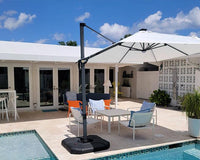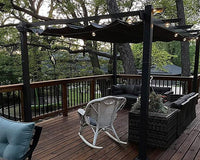As a patio living enthusiast who's lost a couple of umbrellas, I can tell you that a gusty day can transform your serene oasis into a "Wizard of Oz" moment in a matter of minutes. But no worries! With some smart tricks, you can secure your shade provider in place, even during windy weather. Here are five easy methods to stabilize your outdoor umbrella.
1. Get Heavy: The Importance of a Weighted Base
This sounds easy, but it's the plain backbone of umbrella protection, and you'd be amazed at how many people underestimate it. That little plastic base that came with your bargain umbrella? It's probably not going to amount to much when a gust hits. You need lots of weight down at the bottom to counteract the force the wind exerts on the large canopy.
Think of your umbrella like a giant lever. The wind pushes on the top (the canopy), and if there isn't enough counterweight at the bottom (the base), it's going to tip. For most standard-sized patio umbrellas (say, 7 to 9 feet in diameter), you should be looking for a base that weighs at least 50 pounds, and honestly, heavier is often better, especially if you live in a windy area or have a larger umbrella. For cantilever or offset umbrellas, which have a much larger "sail" effect because their support is to the side, you'll need even more substantial weight, often 100 pounds or more, sometimes distributed across multiple fillable sections.
What kind of weights work best?
- Dedicated Heavy Bases: These are purpose-built from materials like concrete, granite, or heavy-duty resin designed to be filled with sand or water. Sand is generally preferred as it's denser than water, providing more weight for the same volume.
- Fillable Bases: Many affordable options are designed to be filled. Make sure they seal properly to avoid leaks if using water, and pack sand in tightly.
- Supplemental Weights: If your current base isn't quite heavy enough, you can often add supplemental weights. These can be purpose-made "weight bags" that wrap around the pole or sit on the base, or even DIY solutions like sandbags (neatly covered, of course, to maintain aesthetics!).
Don't skimp on the base; it’s your first and most important line of defense against a wind-tossed umbrella. A well-weighted base provides the stability needed to resist those initial pushes and shoves from the wind.Before purchasing a base, however, it's important to ensure compatibility with your specific umbrella, as pole diameters and designs can vary significantly between models.

2. Tie It Down: Strategic Use of Umbrella Ties or Cords
Most umbrellas come with a tie built into them, usually a Velcro strap or fabric cord to keep the canopy shut. Use it! But we can improve on that for when the umbrella is open and in use, especially if you're predicting windy weather.
For additional protection with the umbrella in the open position, you can employ exterior ties or heavy rope. The idea is to have anchor points to keep the umbrella from swaying and flying off.
- To a Sturdy Structure: If you have your umbrella near a deck railing, a solid fence post, or even the house side (make sure it will not rub or damage), secure it with weather-resistant bungee cords or ropes to create a stabilizing link. Fasten one end to a secure position at the umbrella pole (never the canopy ribs, as this could damage them) and the other end to your stable anchor. Do not fasten it too tightly to pull on the umbrella, but tightly enough to prevent uncontrolled movement.
- Ground Anchors: For umbrellas on soft ground (like a lawn), you can use specialized ground augers or heavy-duty stakes with ropes leading up to the umbrella pole. This is more common for larger, semi-permanent umbrella setups.
When using ties, ensure they are secure but also allow for a little give. You don't want to create a rigid system that could cause something to snap under a strong gust. The goal is to limit wild swaying and prevent the wind from getting under the canopy and lifting it like a kite. And always, always use the built-in tie to secure the canopy tightly when the umbrella is closed and not in use – this significantly reduces its wind profile.
3. Mind the Tilt and Vent: Using Features to Your Advantage
Many modern patio umbrellas come with features designed not just for optimal shade, but also to help manage wind. Understanding and utilizing these can make a surprising difference.
While primarily for angling, the shade as the sun moves, the tilt feature can be strategically used in windy conditions. If the wind is coming predominantly from one direction, tilting the umbrella into the wind (so the top of the canopy faces the wind) can sometimes reduce the "sail" effect. This allows the wind to flow over the top more easily, rather than catching underneath and trying to lift it. Experiment carefully with this, as an aggressive tilt in very strong wind could also put undue stress on the tilt mechanism itself.
Look for umbrellas with a wind vent at the top of the canopy. This is a single or double layer of fabric that allows wind to pass through the canopy rather than getting trapped underneath. This upward airflow helps to relieve pressure that could otherwise cause the umbrella to lift or become unstable. A well-designed vent is a crucial feature for wind resistance. If your current umbrella doesn't have one, consider this a key feature when you next upgrade.
These built-in features are there for a reason. Using the tilt thoughtfully and ensuring your umbrella has a good vent system are passive ways to enhance its stability without needing extra equipment.

4. Location, Location, Location: Strategic Placement
Where you position your umbrella can significantly impact how much wind it's exposed to. A little strategic thinking can save you a lot of hassle.
Try to place your umbrella in a spot that offers some natural windbreak.
- Near a Wall or Fence: Positioning your umbrella closer to a house wall, a sturdy fence, or a line of dense shrubs can help to reduce the amount of direct wind hitting it. These structures can disrupt the wind flow and create a more sheltered microclimate for your seating area and umbrella.
- Avoid Wind Tunnels: Be mindful of "wind tunnel" effects that can occur between buildings or other large structures. These areas can experience significantly higher wind speeds than more open spots.
- Consider Prevailing Winds: Pay attention to the typical wind direction in your yard. If possible, orient your seating area and umbrella so that larger structures provide a buffer from the most common wind patterns.
While you can't always control the wind, you can often choose a smarter location for your umbrella that minimizes its exposure. This, combined with a heavy base, can make a big difference.

5. Know When to Fold 'Em: Closing Your Umbrella
This is perhaps the simplest, yet most effective, piece of advice: if the winds get genuinely strong, or if you're not actively using the umbrella, close it and secure it tightly with its tie. No umbrella, no matter how well secured, is designed to withstand gale-force winds while open.
Leaving an umbrella open in high winds is inviting trouble. It puts enormous stress on the pole, the ribs, the base, and any tie-downs you might have. It's the quickest way to damage your umbrella or have it become a dangerous projectile.
- Daily Practice: Make it a habit to close your umbrella at the end of the day or when you're finished using it.
- Weather Watching: Keep an eye on the weather forecast. If strong winds or storms are predicted, close and secure your umbrella well in advance.
- "When in Doubt, Close It Out": If the wind starts making you feel uneasy about the umbrella's stability, don't wait for it to become a problem. Close it down.
This future-thinking is the ultimate shield. It's a bit of a bother, maybe, but it will lengthen the lifespan of your umbrella substantially and prevent wind accidents. Proper maintenance is just as crucial for protecting your umbrella from other elements like sun and rain.




